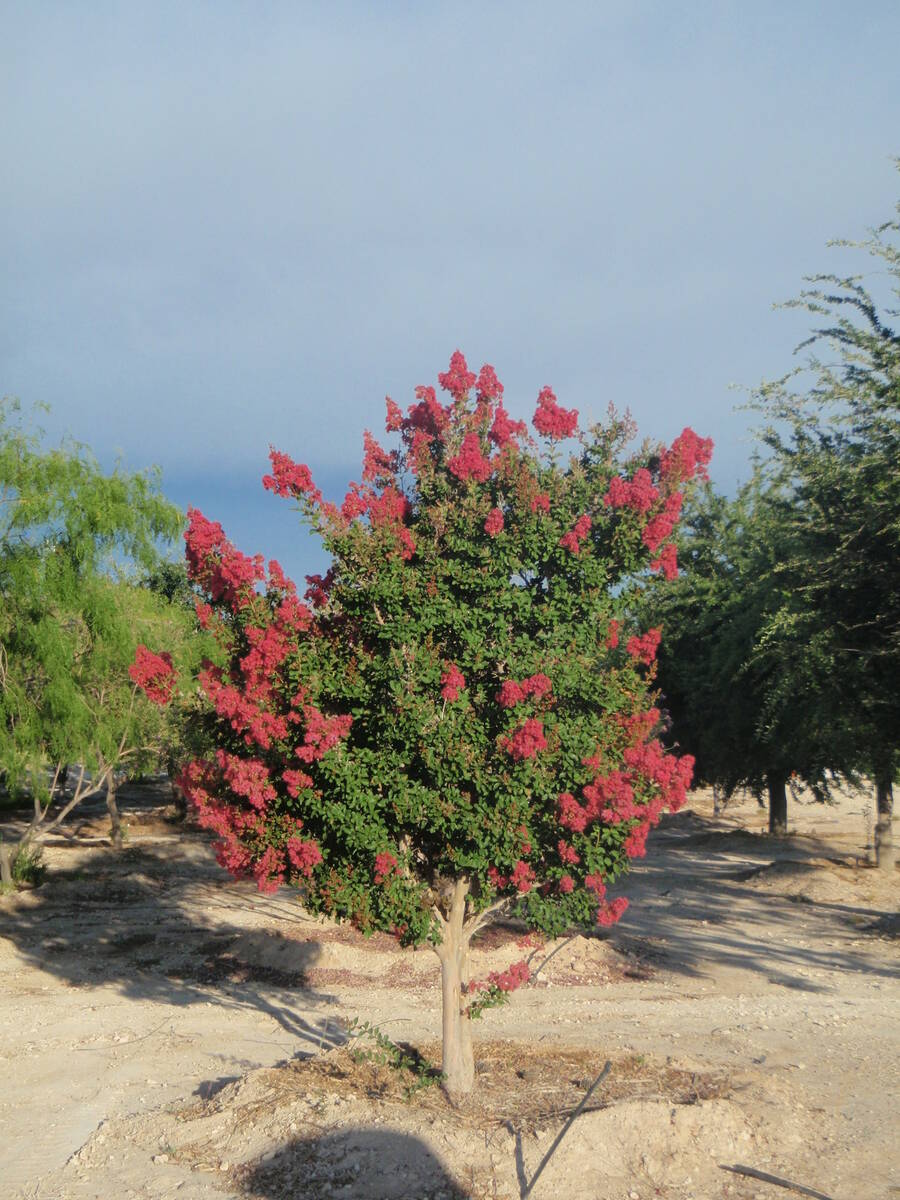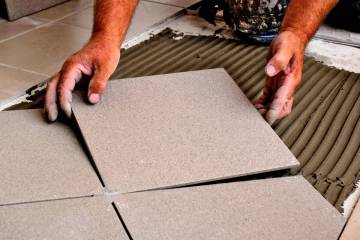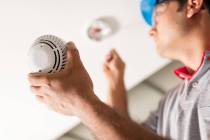Soil moisture sensors are not always reliable
Q: You recently gave me some advice on planting a crape myrtle tree. I dug the planting hole as deep as the container and five times wider, but I didn’t do a water percolation test to make sure the planting hole drained water. I backfilled the hole with a 50/50 mix of the existing dirt plus a rich Viragrow compost. However, a soil sensor constantly registered a “10” (very wet) even for weeks after a single watering.
A: Be careful when buying a soil moisture sensor. Sometimes they don’t always work.
Before buying it, wet your hand and make sure the sensor on the tip is working. A wet hand grasped tightly around the tip should move the needle to the 10 you mentioned or at least close to it. When the sensor is in the dry open air, the needle should read 0 or close to it. Buy only moisture sensors that are working properly and check them to make sure.
Crape myrtle trees are from the eastern and colder parts of Asia including northern and central China, Korea and Japan. When it was introduced to England during the mid-1800s, it didn’t flower profusely because it was not hot enough. This tree, much like the native Carolina laurel, really likes the heat of the South and Southeastern parts of the U.S. for flowering.
The reasons it was introduced to the desert were because it likes the heat, is fairly drought tolerant and tolerates a wide range of soil alkalinity. Crape myrtle doesn’t like soils without compost, the very intense west and south sides without some afternoon shade and the low humidity of our desert. In our climate, this tree likes northern and eastern exposures, and regularly amended soil.
If the soil is not draining water very well, then mound the soil where you’re planting to a height of 12 inches and 4 feet in diameter. Do not plant in the bottom of a swale unless it likes the soil swampy. The soil mound allows for the roots of the plant to grow by providing water drainage to the lower soil surrounding the tree.
Q: I’m concerned with the appearance of the jasmine vine and rose bushes in my yard. I fed everything 1 cup of Epsom salt two months ago and fed the rose bushes rose food last month and this month. I watered thoroughly before and after feeding. My yard is on a drip system that waters for 30 minutes three times a week.
A: It’s true some rosarians like to give their roses Epsom salts, but this does not excuse the condition of your plants. Epsom salts provide the soil magnesium in the sulfate form. Typically, in our alkaline soils compost has enough magnesium to enrich the soil without using Epsom salts. Make sure the soil used in mounding drains water.
I don’t know which side of the house or wall your trees are growing, but the preferred landscape exposure for both plants is the east and north sides of a home or wall.
Both jasmine and roses like soil amended with compost. About a half-inch of compost sprinkled on the soil each year is enough to keep these plants healthy and growing at their best.
Just like us, when these plants are healthy, they can handle heat and cold better. When these plants are not healthy, they are not as tolerant of these extremes in temperature. If the soil is covered in rock and not improved, they will struggle in a few years after planting.
What to do? If the soil is amended with compost at planting time and the surrounding soil is covered in wood chips, usually just fertilizer is all that is needed. The addition of compost sprinkled on the soil surface once a year adds a lot of plant nutrients to the soil that is missing as rock degrades.
Just don’t overdo it and keep rock or wood chips at least 6 inches from the trunk of young plants. Both plants will benefit from annual applications of the EDDHA iron chelate in the early spring.
Q: My sago palm is yellowing. What should I do?
A: The sago palm is also called a cycad.
These plants originated from China and Japan and are grown in nurseries all over the world. They can handle a lot of harsh locations including poor soils but look their best when growing in filtered shade and sandy but enriched soils.
If I were to grow them in a landscape in the desert, I would put them on the east or north sides of a home or wall spacing them about 3 feet apart and 3 feet from walls and buildings. Keeping in mind they like filtered light, I would find a place where sunlight is intermittent. They give a tropical and jungle-like look to a landscape and should be used where there are lots of other plants growing as well.
The soil should be enriched and covered with 3 to 4 inches of wood chips or wood chip mulch and need between 5 and 10 gallons of water each time they are irrigated. They are mesic in their water use and should not be watered with the same valve used for desert plants such as cactus, saguaro, Joshua trees, ocotillo and the like.
The absolute worst way to grow this plant is on the west or south sides with reflected heat, grown in unimproved soils covered in rock and watered like a desert plant.
Q: A few years ago I was lucky enough to get a Japanese dwarf pomegranate to grow from a 6-inch cutting. It is now over 5 feet tall. What is a properly pruned pomegranate supposed to look like?
A: The Japanese dwarf pomegranate is an ornamental shrub. It is not valued for its fruit.
Pruning it is like any other ornamental shrub; pruning is done after flowering has finished. I am guessing your ornamental pomegranateflowers through most of the year, so it is pruned in the winter after leaf drop, just like pruning pomegranates that are used for their fruit.
The five-to-six-stem rule that we use for pruning fruit-bearing pomegranate is not important if we are using it as an ornamental. This means you can leave as many stems as you want.
As the shrub gets taller, remove 1/4 to 1/3 of the largest stems by pruning them close to the ground. You should be removing three or four of the larger stems every two to three years. Pomegranates grown for their fruit are pruned every year during the winter.
Q: Can I use burlap for shade cloth?
A: Don’t use burlap as a solid piece in place of shade cloth for permanent shade. It is fine for creating permanent shade for people or pets but not for plants. Be careful how much heat it traps under it if it is located too close to humans and other animals.
Plants are green and need sunlight for photosynthesis — usually about 60 to 70 percent sunlight. People and pets don’t need as much.
Use shade cloth instead. It comes in different percentages of shade ranging from about 30 to 100 percent. Shade cloth for plants ranges from 20 to about 50 percent shade. Plants that flower and produce fruits like tomatoes, peppers, and eggplant need more light than leafy plants: 20 to 40 percent shade. Shade more than this interferes with flowering and fruiting.
Plants that only grow leaves and no flowers such as lettuce, spinach, Swiss chard, greens can handle shade up to about 50 percent. After 50 percent shade, they grow poorly. Too dark. Not enough light. Most burlap I have seen produces much more shade than this and would not be a good choice when growing plants.
You can make 50 percent shade out of wooden 1-by-2s by omitting every other piece of wood. These are called lathe houses. Similarly, 30 to 40 percent shade can be done the same way but by eliminating two and leaving every third 1-by-2.
Bob Morris is a horticulture expert and professor emeritus of the University of Nevada, Las Vegas. Visit his blog at xtremehorticulture.blogspot.com. Send questions to Extremehort@aol.com.





























